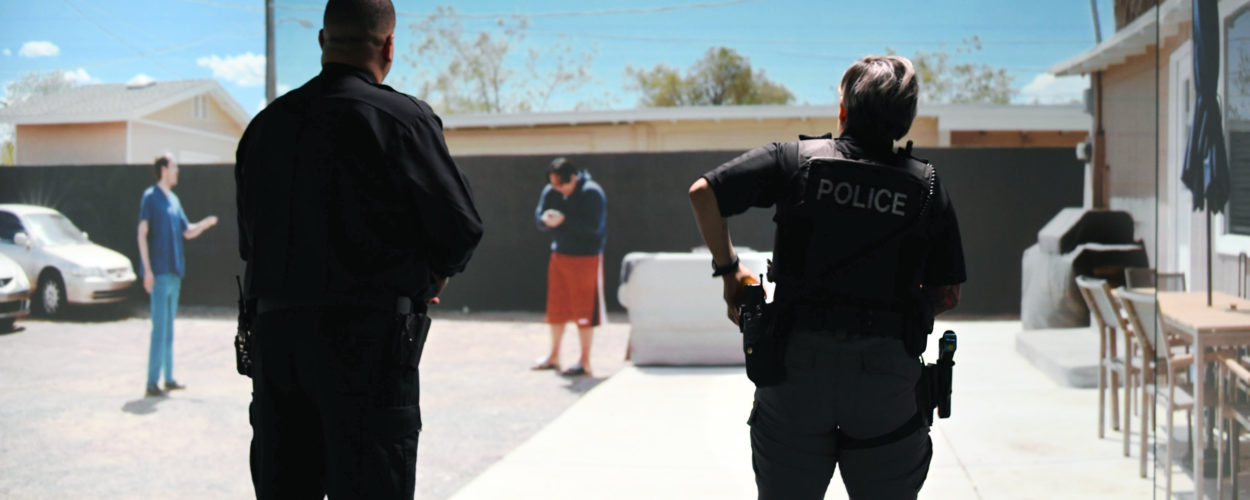
Originally published by Police1
The science behind simulation training is robust and well-established. However, many police trainers are not taking full advantage of simulators to not only impact outcomes but to improve the use of law enforcement’s limited training time.
There are many ways agencies can leverage these advantages. Accounting for the critical influence of the spacing effect and interleaving can have positive impacts on training efficacy.
Spacing
The spacing effect is an established phenomenon in psychology that has been supported by several studies. [1-3]
By spacing out study sessions, the brain can consolidate information more effectively and transfer it from short-term memory to long-term memory enhancing learning and retention. [1,4]
Rather than cramming (massing) all necessary training into a single session, spread it out over several sessions. This will give officers time to process and consolidate the information they are learning, which can improve their retention of the material. [4]
Research has shown that spaced training sessions can improve the retention of skills and knowledge, [4] as well as reduce the risk of errors and accidents. This effect can be particularly useful in police firearms training, as it can help officers to learn and retain the necessary skills to use their weapons safely and effectively.
Many agencies engage in a quarterly 10-hour training day, or some type of massed practice. The reality is a half hour each week spread over that same quarter provides more training value.
I recommend a method called “extended briefing training.” This concept maximizes the value of the overlap that often occurs when one shift is coming to work while another is still on the road. This shift overlap provides a training opportunity that can mitigate overtime and staffing issues connected to training and bring significant results. These micro-training moments are impactful. When the simulator is available for this extended briefing training it can facilitate spaced practice. The VirTra simulator and certified VICTA content would allow for a 15-20min firearms practice session on Monday, work on contact and cover on Tuesday, threat discrimination on Wednesday, and de-escalation on Thursday. The following week these and other skills can be worked in.
Interleaving
Interleaving training involves mixing up different types and practice exercises rather than focusing on just one type at a time.
For example, rather than spending an entire session practicing one shooting technique, officers could alternate between practicing different techniques, engaging in scenario-based training, and reviewing relevant policies and procedures. This can help enhance learning by forcing officers to apply their skills and knowledge in a more varied and challenging context. [5,6]
Simulation training is a powerful way to create interleaving. Using a three-screen or five-screen simulator, concepts such as contact and cover, less-lethal deployment, de-escalation, active shooter and basic firearms skills can all be mixed into the training session. This prevents Maslow’s Hammer problem, where if you are over-reliant on a hammer, you are more apt to treat everything as if it is a nail. It also forces a key piece of all law enforcement contacts: decision-making.
This type of practice involves breaking training sessions into shorter, more frequent sessions, rather than one long session. For example, rather than conducting a four-hour training session, or that 10-hour session mentioned earlier, officers could instead have four one-hour training sessions spread out over several weeks. This can help to minimize the effects of fatigue and enhance learning. [7] Allowing officers to train with a deliberate focus on it, minus the fatigue that sets in mentally and physically within an hour for most, provides advantages over longer, less focused sessions.
Overall, by using the spacing effect and interleaving to enhance police training, officers can improve their ability to use their weapons safely and effectively and train in decision-making while reducing the risk of accidents and errors on the job. This can ultimately contribute to the safety and well-being of both officers and the communities they serve.
References
1. Cepeda NJ, Pashler H, Vul E, Wixted JT, Rohrer D. (2006.) Distribute practice in verbal recall tasks: A review of quantitiative synthesis. Psychological Bulletin, 132(3), 354-380.
2. Donovan JJ, Radosevich DJ. (1999.) A meta-analytic review of the distribution of practice effect: Now you see it, now you don’t. Journal of Applied Psychology, 84(5), 795-805.
3. Roediger HL, Karpicke JD. (2006.) The Power of Testing Memory: Basic Research and Implications for Educational Practice. Perspectives on Psychological Science, 1(3), 181–210.
4. Anderson R, Sebaldt A, Lin Y, Cheng A. (2019.) Optimal training frequency for acquisition and retention of high-quality CPR skills: a randomized trial. Resuscitation, 135, 153-161.
5. Shea JB, Morgan RL. (1979.) Contextual Interference Effects on the Acquisition, Retention, and Transfer of a Motor Skill. Journal of Experimental Psychology: Human Learning and Memory, 5, 179-187.
6. Taylor K, Rohrer D. (2010.) The effects of interleaved practice. Applied Cognitive Psychology, 24(6), 837-848.
7. Dempster FN. (1989.) Distributing and managing the conditions of encoding and practice. In L. S. Cermak & F. I. M. Craik (Eds.), Levels of processing in human memory (pp. 317-344). Lawrence Erlbaum Associates.
Recently Published
Join Our Newsletter







